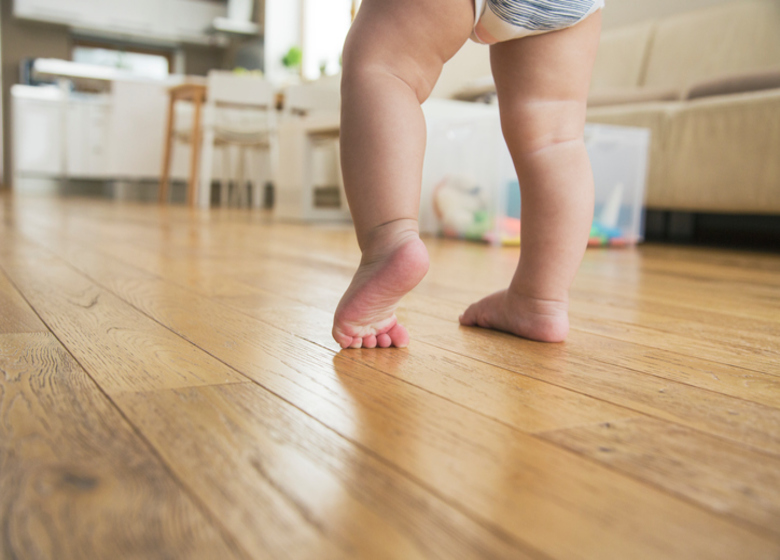Toe walking is a common practice for many children when they just start walking. Most kids grow out of it as they grow older and it’s usually known that they disappear completely after age three. Nonetheless, if your child continues to walk excessively on his or her toes then you may need to consult a doctor about this habit. Scroll down to know more about toe walking in children.
What is Toe Walking?
The practice of walking on the tip of the toes is toe walking. Children walking on tiptoes prefer not to touch their feet to the ground as they step forward. This is a habit that children learn when they start walking around holding onto furniture, and is considered normal in children up to 2 or 3 years of age. If it continues beyond this age, however, it may mean that your child has made a habit of it or has other issues.
Causes of Toe Walking In Children
Toe walking in children is usually no cause for concern, as it subsides after two or three years. However, if not, it may be associated with some underlying causes and conditions. Some of the causes of toe walking in children are discussed below:
1. Periventricular Leukomalacia
In some cases, premature babies can experience nerve damage which can lead to walking difficulties. This could lead to walking feet and other walking issues.
2. Cerebral Palsy
Many forms of cerebral palsy lead to standing and walking difficulties. It is known that spastic cerebral palsy makes the muscles around the feet very stiff which can cause difficulties while walking. Many premature babies may also have a brain hemorrhage that can cause cerebral palsy and lead to walking difficulties, facilitating toe walking.
3. Short Achilles tendon
Kids with short Achilles tendon would find it difficult to completely stretch it. This could allow them to walk on their toes and even stop them from standing flat on their feet.
4. Idiopathic toe walking
It can be idiopathic toe walking if your child has no underlying condition leading to toe walking and has normal movement in the ankle joint but continues walking on his or her toes. It essentially means that there is no specific reason for it and may have grown by consequence of his toe walking.
Complications of Toe Walking In Children
Although toe walking is normal in many children up to three years of age, the risk of developing idiopathic toe walking may be higher in families with a history of children who had the problem.
Constant toe walking may damage the children’s joints and muscles, and may even increase their risk of falling and stumbling. His peers may also render him subject to criticism as he develops, which can affect his confidence.
Diagnosis
The diagnosis for toe walking is as easily observed through a physical exam. However, in some cases, the doctor may also do a gait analysis or an EMG (electromyography). To assess the electrical activity during an EMG, a thin needle is inserted into the affected muscles or nerve along with an electrode. If toe walking is the product of developmental delays, autism or cerebral palsy, a neurological test or cognitive assessment may be recommended by the doctor to identify the cause.
Treatment
If your child’s toe walking continues beyond the age of three and you’re worried, you might want to get a test that can determine the cause of your child’s toe walking. The right course of treatment and therapy will avoid the risk of harm to the joints and muscles. The doctor may suggest the following treatment options for your child, depending on the cause of the toe walking.
1. Ankle-foot orthosis
Therapists may also ask the child to wear an orthosis on ankle-foot. This is a plastic brace, which keeps the foot at an angle of 90 degrees and stretches to the back of the leg. The brace can be worn all day and night and can be removed during bathing or exercises.
2. Serial casting
An orthopedist may apply a cast of plaster or fiberglass to allow the tendons to spread and to provide a better range of ankle mobility for your child. As the tendon stretches, the cast will be adjusted every other week and removed when the tendon is long enough. Unable to remove this cast when needed.
3. Surgery
If your child is not responsive to other treatment courses, the doctor may recommend surgery to stretch out the tendon.
4. Physical therapy
Stretching and physical therapy exercises may be used to treat children with a short Achilles tendon.
Preventions
1. Stretches
Toddlers lack flexible muscles. Stretches can help loosen the stiff muscles in their ankles and give them a better range of motion.
2. Shoes
With good ankle support, the right shoes will avoid toe walking. You should sometimes ask your kid to wear house shoes to help him balance on his feet.
3. Ankle weights
These can help lengthen the tendon of your infant and allow him to walk flat on the ground on his feet. Always use the proper dimensional weights and consult a doctor before doing so.
Toe walking is very common in children and, in most cases, is no reason to worry. However, if you notice that even after your child is growing, you may want to consult with a health care professional to rule out any serious problems.
Also Read: Autism In Kids – Sign, Symptoms, And Treatment













